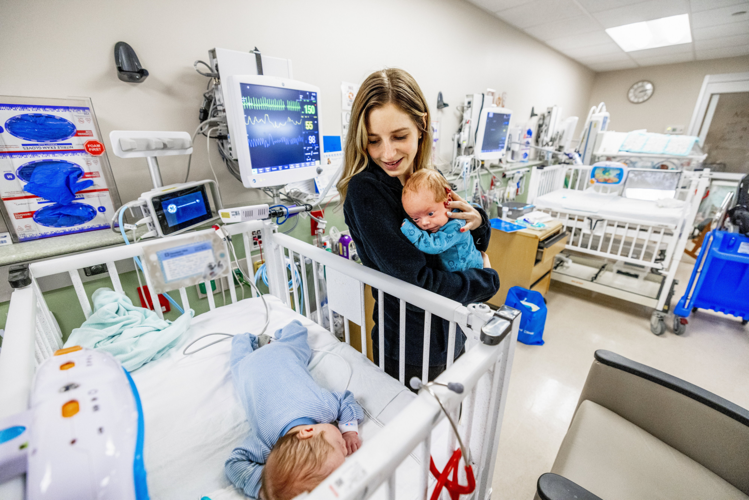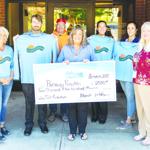
(Cleveland Clinic via SWNS)
By Ben Barry
A set of identical twins is thriving after life-saving surgery was performed on them while they were still in the womb.
Jessica Proudfoot, 29, was 20 weeks pregnant when she discovered that her twins, Graylen and Chaysen, had twin-to-twin transfusion syndrome (TTTS).
While most identical twins share blood and nutrients from the same placenta equally, twins affected by TTTS do not. Instead, one twin receives less blood supply than the other twin.
The imbalance deprives one baby of the nutrients it needs while providing an excess of nutrients to the other – leading to serious risks and complications.
On July 10, 2024, Jessica underwent a fetoscopic laser ablation - a minimally invasive surgical procedure used to treat certain conditions in multiple pregnancies - at Cleveland Clinic Children's Fetal Care Center.
The operation was a success, and Graylen and Chaysen, now one, were delivered at 31 weeks and six days on September 20, 2024.
They spent 80 days in the neonatal intensive care unit to build up strength before coming home to be with Jessica, their dad, Andrew Cross, 31, and their big sister, Elliana, age three.

(Cleveland Clinic via SWNS)
Jessica, a patient access coordinator, from Canal Fulton, Ohio, said: “We’ve got some strong boys to make it through everything they did, and I’m so grateful to be able to hold them in my arms today.
“Whatever I have to do to save them is what I’m doing – that was my first thought after getting the diagnosis."
During her routine pregnancy check-ups, doctors discovered Jessica was carrying monochorionic twins, which are identical twins that share one placenta.
About 10 percent to 15 percent of these cases will go on to develop TTTS.
Jessica said: “I wasn’t too worried about twin-to-twin transfusion syndrome even being a possibility because the chances of that occurring were just so small.
"But we ended up having that small chance happen."
Courtney Stephenson, DO, a maternal-fetal medicine specialist and the Director of Fetoscopic Intervention at Cleveland Clinic Children's Fetal Care Center, said: “The twin that gives blood to the other ends up having low blood volume, which reduces their kidney function and urine production.

(Cleveland Clinic via SWNS)
"On the other hand, the recipient twin is generally larger with volume overload, placing the heart under significant pressure, which can lead to cardiac dysfunction.
"If left untreated in severe, early-onset cases, twin-to-twin transfusion syndrome is associated with high mortality."
On July 10, 2024, Jessica underwent a fetoscopic laser ablation, which involves the surgeon inserting a small camera into the uterus to identify and map out any abnormal blood vessels on the surface of the placenta.
The surgeon then uses a laser to close off those blood vessels that are causing one twin to get too much blood and the other to receive too little.
“It was scary leading up to the surgery, and we prayed a lot. But I put my faith in Dr. Stephenson and this procedure,” says Jessica.
The laser ablation was a success, and the twins started making progress shortly after. Their blood volumes and fluid levels were evening out sooner than expected.
Jessica’s care team continued to watch her closely, and after several weeks into the third trimester, they noticed the twins’ legs were in the same sac.
This meant the umbilical cords could get tangled.
After this discovery, she was admitted to the hospital for monitoring until the babies were able to be delivered by C-section at 31 weeks and six days gestation, on September 20, 2024.
“We were so relieved to hear them both crying. I was just thinking those are my boys and thank God they’re OK,” says Jessica.
Since the twins had to be delivered prematurely, they needed to be cared for in the neonatal intensive care unit (NICU) as they continued growing.

(Cleveland Clinic via SWNS)
Jessica would visit them at Cleveland Clinic Fairview Hospital every day, but during the hours she couldn't be there, she knew they were in good hands.
Jessica said: “The NICU team was amazing. It was really nice to have a group of nurses who not only comforted me but were there for the boys day and night.
"They knew them front to back and could not have been in better hands."
Graylen and Chaysen were in the NICU for nearly three months until they were able to come home and be with Jessica, Andrew and their big sister, Elliana.
As the twins continue reaching new milestones, Jessica says their personalities are starting to shine.
Graylen loves being held and cuddled – while Chaysen is more independent and enjoys watching his sister play.
Jessica said: "When I was in the hospital, I had to be strong for them because I knew they were feeling everything I was.
"Dr. Stephenson and her team helped make us feel comfortable in a very uncomfortable situation."
























(0) comments
Welcome to the discussion.
Log In
Keep it Clean. Please avoid obscene, vulgar, lewd, racist or sexually-oriented language.
PLEASE TURN OFF YOUR CAPS LOCK.
Don't Threaten. Threats of harming another person will not be tolerated.
Be Truthful. Don't knowingly lie about anyone or anything.
Be Nice. No racism, sexism or any sort of -ism that is degrading to another person.
Be Proactive. Use the 'Report' link on each comment to let us know of abusive posts.
Share with Us. We'd love to hear eyewitness accounts, the history behind an article.